Turning your yard into a beautiful outdoor space can seem hard. But, with the right raised bed garden ideas, it’s easier than you think. Raised beds help control soil and extend growing seasons, making them perfect for gardening. This guide will help you design, build, and keep a raised bed garden thriving, whether you’re new to gardening or not.
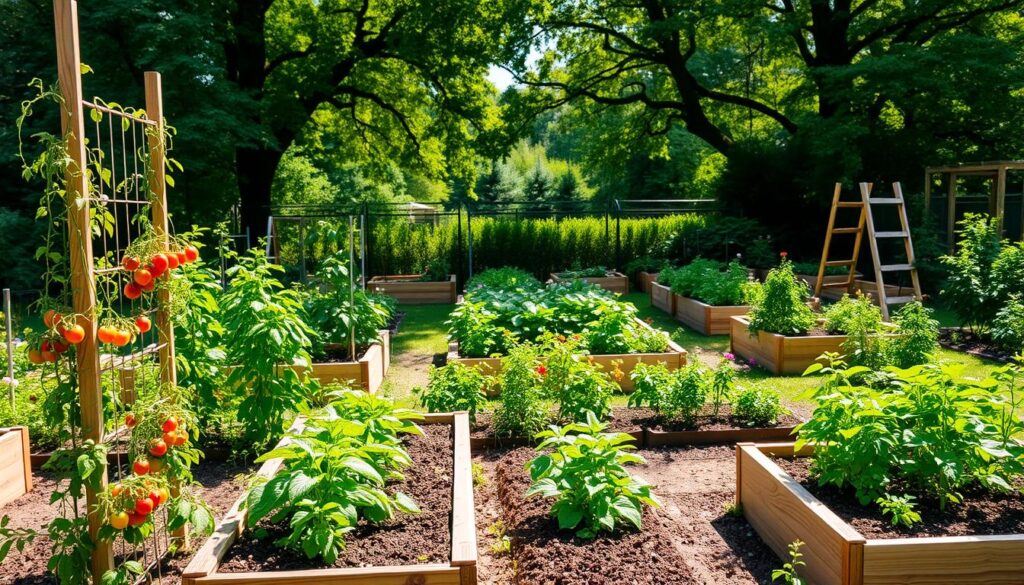
With careful planning, you can make a beautiful outdoor area that shows off your style and meets your needs. We’ll cover everything from garden design to creating a welcoming outdoor space. Our aim is to give you the tools and ideas to make your dream garden a reality with raised beds.
Key Takeaways
- Raised bed gardening offers better soil control and an extended growing season
- Proper garden design is essential for a thriving raised bed garden
- Outdoor living spaces can be created with raised beds, regardless of yard size
- Raised bed garden ideas can be customized to fit your personal style and needs
- With the right planning and execution, you can create a stunning outdoor living space
Benefits of Raised Bed Gardening
Raised bed gardening has many perks for gardeners. It’s great for those wanting to get the most out of their garden. With raised bed plans, you can control the soil better, avoid back pain, and grow plants longer. These benefits are crucial for small gardens where space is tight.
Some key benefits of raised bed gardening include:
- Better soil control and drainage, allowing for more precise management of soil quality and composition
- Reduced back strain and easier access, thanks to the elevated nature of raised beds
- Extended growing season, as raised beds warm up faster in the spring and cool down slower in the fall
By using gardening tips and small garden ideas in raised bed gardening, you can make a garden that thrives. It’s perfect for both new and experienced gardeners. Raised bed gardening helps you get the most from your garden.
| Benefit | Description |
|---|---|
| Better Soil Control | More precise management of soil quality and composition |
| Reduced Back Strain | Easier access and reduced need for bending and kneeling |
| Extended Growing Season | Raised beds warm up faster in the spring and cool down slower in the fall |
Essential Raised Bed Garden Planning Tips
Creating a thriving raised garden starts with landscape design. As a beginner, start small with plants like tomatoes or herbs. Knowing your climate and plant needs is key. A well-planned garden looks great and works well, making gardening a success.
When planning your raised garden, think about its size and location. Consider the space you have and how much sunlight your plants need. For a vegetable garden, choose a spot with at least 6 hours of direct sunlight. Also, pick the right soil and materials for building.
Important planning factors include:
- Climate and weather conditions
- Soil type and quality
- Plant selection and spacing
- Irrigation and watering systems
By planning carefully, you can make a beautiful and productive garden. Research your plants’ needs and seek advice from experts in landscape design and gardening for beginners.
“Creative Raised Bed Garden Ideas for Small & Large Spaces
Raised bed gardens can grow in almost any spot, from city balconies to big backyards. Adding a flower garden to your design makes it look great and helps pollinators. Keeping up with garden maintenance is crucial for a healthy and beautiful garden.
There are countless raised bed garden ideas out there. In cities, use vertical space with trellises or wall planters. Big yards can have bigger raised beds for more designs. Some cool ideas include:
- Creating a focal point with a large planter or sculpture
- Using a mix of plants with different textures and colors to add depth and interest
- Incorporating a seating area or pathway to create a inviting space
By using these ideas and keeping your garden up, you can make a stunning raised bed garden. It will make your outdoor area more enjoyable. Choose plants right for your area and water and feed them often.
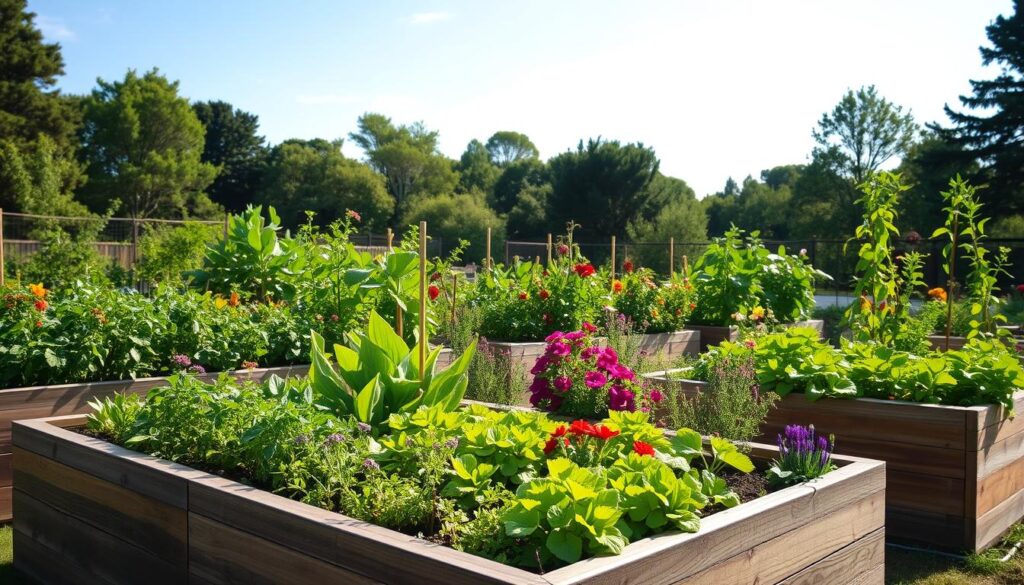
How to Choose the Best Location for Your Raised Bed Garden
When designing your garden, the spot you pick is key. Think about sunlight, drainage, and how easy it is to get to. Most plants need at least six hours of sunlight a day.
For a great outdoor living area, make sure the soil drains well. This stops water from making the soil soggy, which can harm your plants. Having a spot close to water makes caring for your garden easier.
Some important things to think about when picking a spot include:
- Sunlight: at least six hours of direct sunlight per day
- Drainage: well-draining soil to prevent waterlogged soil
- Accessibility: proximity to a water source and easy access for maintenance
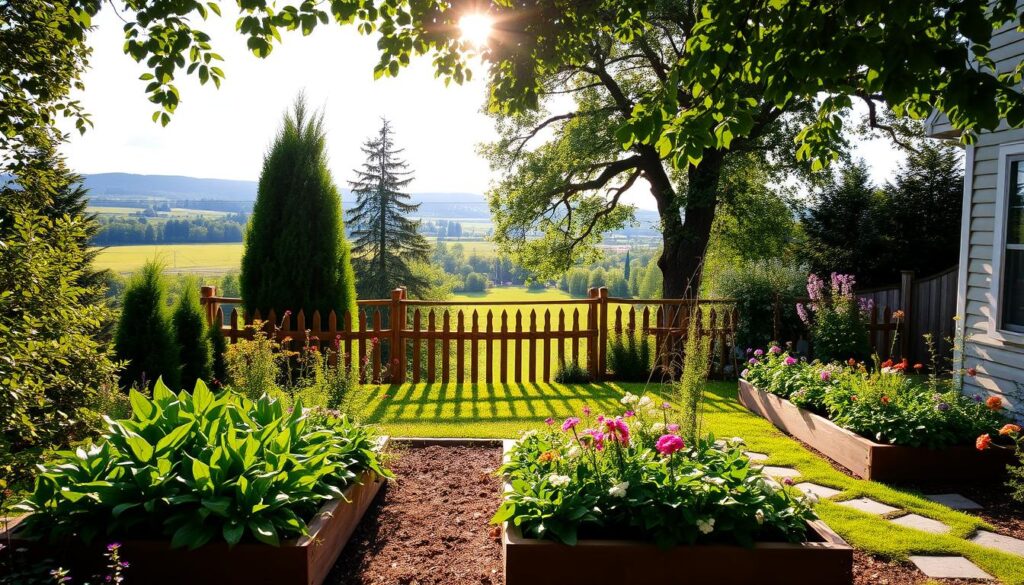
By picking the right spot, you can make a garden that’s full of life. It will also give you fresh food right from your yard. Just remember to follow good gardening tips and try new garden design ideas to make your space special.
Materials and Construction Methods
Choosing the right materials for your raised bed garden is key. It affects both its look and how well it lasts. Consider using high-quality materials for a beautiful and useful garden. Wood is a popular choice, with options like cedar, pine, and recycled wood.
Each wood type has its own benefits and drawbacks. These include how long it lasts, its cost, and its impact on the environment.
For smaller gardens, think about using materials like composite, metal, or plastic. These are great because they need little care and keep pests away. Knowing what tools and hardware you’ll need, like screws and hammers, is important for the project. Choosing the right materials and building it well means less upkeep later. This makes gardening more fun.
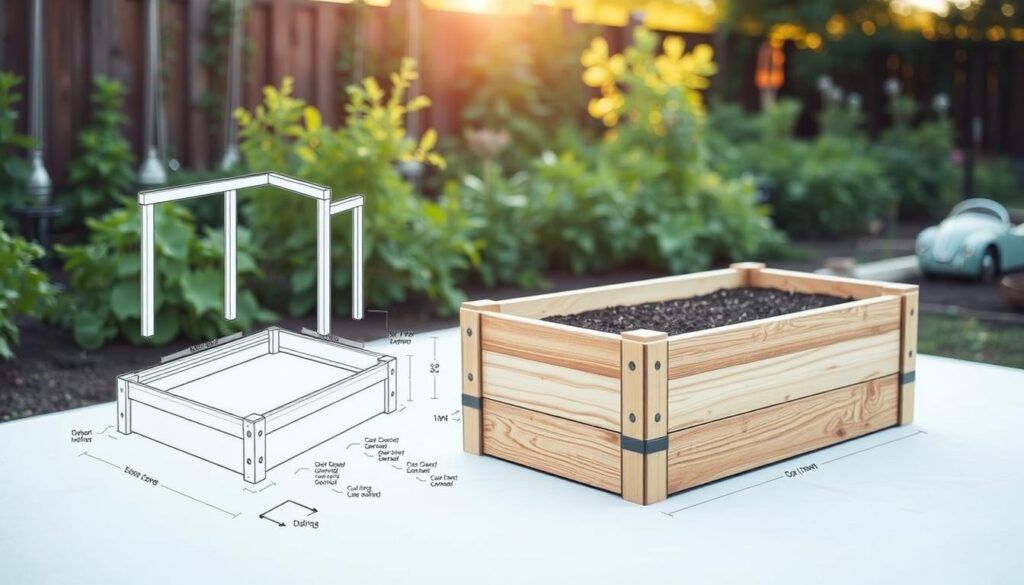
- Wood options: cedar, pine, and recycled wood
- Alternative materials: composite, metal, and plastic
- Tools and hardware: screws, nails, and hammers
By picking the best materials and building methods, you can make a lovely raised bed garden. It will need little care. With the right plans, your garden will flourish, giving you joy and fresh food for years.
Soil Preparation and Filling Techniques
Preparing the soil is key for beginners in gardening. The soil’s quality greatly affects your garden’s success. It provides the nutrients plants need to grow well.
To make a good soil mix, mix topsoil, compost, and perlite or vermiculite. The right mix ratio depends on your plants’ needs. A common mix is 60% topsoil, 30% compost, and 10% perlite or vermiculite. This mix helps your plants grow strong and healthy.
Soil Mix Ratios
- 60% topsoil
- 30% compost
- 10% perlite or vermiculite
Layering methods can also improve soil quality. Adding compost or manure enriches the soil. Knowing your soil’s pH level and adjusting it helps your plants get the nutrients they need.
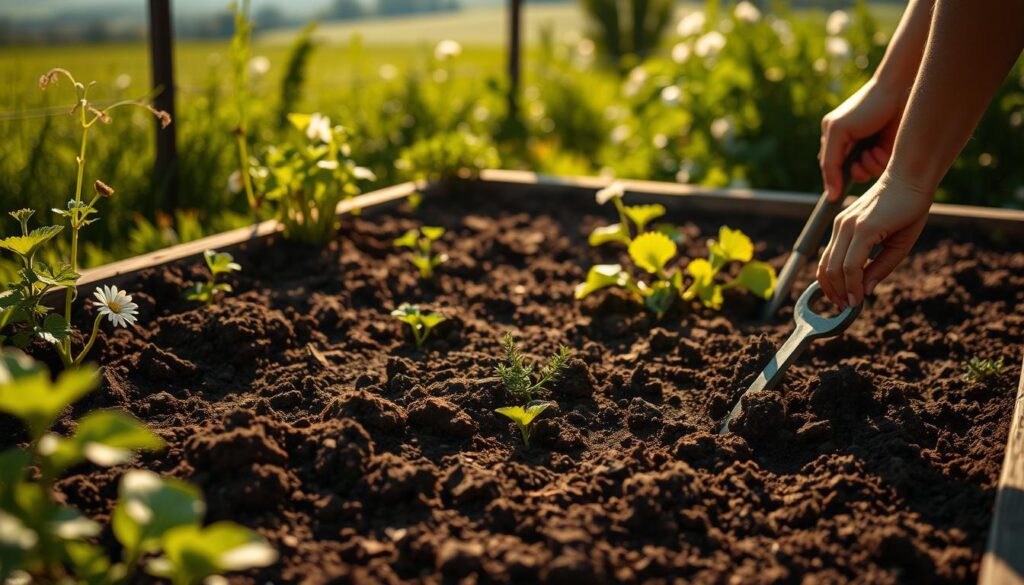
By using these soil preparation and filling techniques, you can create a vibrant garden. Whether it’s a vegetable or flower garden, it will bring you joy. Always remember, soil quality is the heart of a healthy garden.
Plant Selection and Layout Strategies
Creating a thriving garden starts with plant selection and layout. A well-designed garden is both beautiful and functional. It makes the most of the space available. Mixing vegetables, herbs, and flowers adds beauty and improves growth through companion planting.
In garden design, think about the mature size of plants and their growth habits. Also, consider their compatibility. Knowing each plant’s needs, like sunlight and watering, helps design a layout that meets those needs. This way, you can enjoy a thriving outdoor space that brings joy and fresh produce.
Some key considerations for plant selection and layout include:
- Choosing plants that are compatible with each other
- Considering the mature size of plants and leaving enough space for growth
- Understanding the specific needs of each plant, such as sunlight and watering requirements
By following these gardening tips and incorporating them into your garden design, you can create a beautiful and functional outdoor living space. This enhances your overall
Irrigation Solutions for Raised Beds
Keeping your raised bed garden healthy requires good irrigation. The right irrigation system is key for garden care. A drip irrigation system is a great choice. It waters plants at the roots, cutting down on evaporation and runoff.
Water conservation is vital for small gardens. Using rainwater or greywater can save a lot of water. Here are some ways to do it:
- Collecting rainwater in a barrel or tank
- Using greywater from sinks, showers, or washing machines
- Implementing a drip irrigation system
Automated watering systems, like timers and sensors, help too. They make sure plants get the right water at the right time. These solutions keep your garden healthy and green, all while being kind to the planet.
Adding these smart irrigation methods to your garden care routine is a smart move. You’ll get a beautiful, productive garden. Plus, you’ll use less water and help the environment.
Seasonal Maintenance Tips
As a beginner in gardening, knowing about seasonal maintenance is crucial. It helps keep your garden healthy and growing well. Tasks like pruning, watering, and fertilizing need to be done at the right time.
In spring, focus on pruning and planting new seeds. Summer needs lots of watering and mulching to keep the soil moist. Fall is for cleaning up and protecting plants from bad weather. Winter is the best time to insulate the soil and plan for next season.
Here are some seasonal maintenance tips to remember:
- Watch for pests and diseases often
- Use fertilizers as needed for growth
- Rotate crops to keep the soil healthy
By following these tips and making a seasonal plan, your garden will thrive all year. Whether it’s a small veggie garden or a big flower garden, regular care is essential for success.
Common Challenges and Solutions
When you care for your raised bed garden, you might face some common problems. These can affect your plants’ health and how well they grow. Good garden maintenance is key to solving these issues. Knowing about these problems and having solutions ready can help keep your garden healthy.
Some gardeners struggle with pests, keeping the soil right, and protecting plants from the weather. Understanding raised bed garden ideas and gardening tips is vital. For example, using barriers or organic pesticides can fight pests. Also, checking your soil’s pH and nutrient levels regularly is important.
To shield your plants from harsh weather, think about using row covers or cold frames. These steps can make your garden strong and low-maintenance. Here are more tips to remember:
- Watch your plants for pests or diseases
- Water your garden well, but avoid too much
- Support plants that need it, like tomatoes or peas
By following these gardening tips and being proactive with garden maintenance, you can get a great harvest from your raised bed garden. Stay alert and ready to adapt to any problems. If you need help, ask experienced gardeners or look up advice online.
Conclusion: Transform Your Garden with Raised Beds
Raised bed gardening is a great way to make your outdoor space better. This guide has shown you how to turn your garden into a lush oasis. You can grow lots of vegetables, beautiful flowers, or just enjoy your outdoor living area more.
Raised bed gardening has many advantages. It helps you control the soil, makes gardening easier on your back, and lets you grow plants longer. You can also make your beds fit your space and style perfectly. Begin planning your raised bed garden now and enjoy the fun of gardening.
FAQ
What are the benefits of raised bed gardening?
Raised bed gardening has many advantages. It allows for better soil control and drainage. It also reduces back strain and makes gardening easier. Plus, it extends the growing season.
What are the essential planning considerations for a raised garden?
Planning a raised bed garden requires careful thought. You need to decide on the size and location of the beds. Choose the right materials for building and plan the garden’s layout.
How do I choose the perfect location for my raised bed garden?
Picking the right spot for your raised bed garden is key. Look for areas with plenty of sunlight and good drainage. Make sure it’s easy to get to for tending to your plants.
What materials and construction methods should I use for my raised beds?
There are many materials for building raised beds, like wood, composite, metal, and plastic. Each has its pros and cons. Knowing these and the tools you’ll need will help you choose wisely.
How do I prepare and fill the soil in my raised beds?
Preparing the soil is crucial. Mix the right soil ratios and layer them correctly. Add amendments and enrichments to keep the soil healthy.
How do I select the right plants and layout for my raised bed garden?
Pick plants that match your raised beds’ size and needs. Design a layout that’s both productive and visually pleasing. This will make your garden thrive.
What are the best irrigation solutions for a raised bed garden?
Good irrigation is key. Use drip systems and water-saving methods. Consider automated watering options to keep your plants healthy while saving water.
What seasonal maintenance tasks should I focus on for my raised bed garden?
Regular maintenance is vital. Prune, water, clean up, and protect the soil. These tasks will keep your garden healthy all year.
How can I address common challenges in my raised bed garden?
Overcome common problems like pests, soil issues, and weather damage. With the right strategies, your garden will continue to flourish.
